Effective Change Management During M&As
VerifiedAdded on 2020/10/12
|8
|1960
|65
AI Summary
This assignment discusses the significance of effective change management during mergers and acquisitions (M&As). It highlights the need for organisations to consider the culture of other companies being merged with and how best to integrate their cultures and systems. The Lewis 3-Stage Model is presented as a framework for managing change, involving unfreeze, change, and refreeze stages. Effective communication and employee involvement are also stressed as crucial factors in managing change during M&As.
Contribute Materials
Your contribution can guide someone’s learning journey. Share your
documents today.
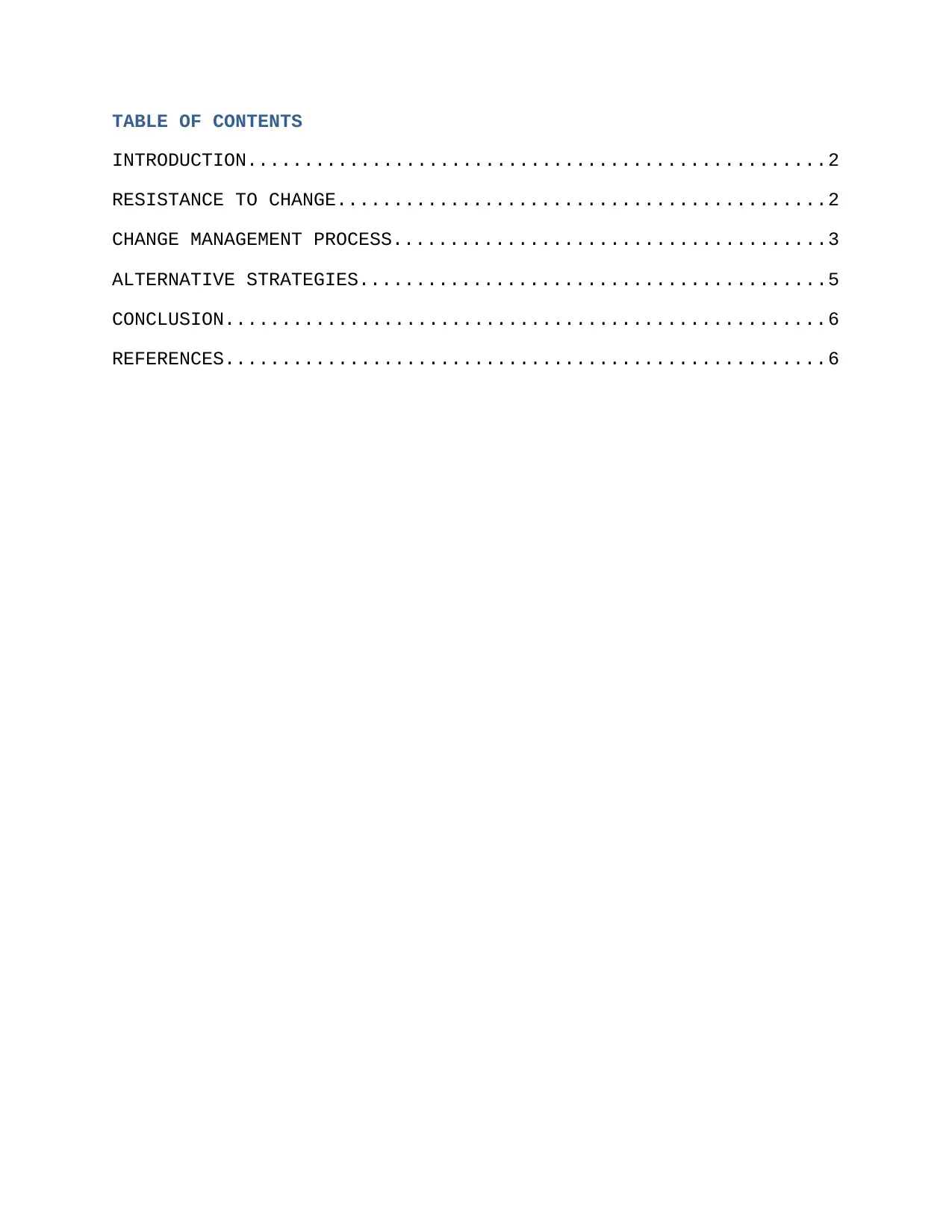
TABLE OF CONTENTS
INTRODUCTION...................................................2
RESISTANCE TO CHANGE...........................................2
CHANGE MANAGEMENT PROCESS......................................3
ALTERNATIVE STRATEGIES.........................................5
CONCLUSION.....................................................6
REFERENCES.....................................................6
INTRODUCTION...................................................2
RESISTANCE TO CHANGE...........................................2
CHANGE MANAGEMENT PROCESS......................................3
ALTERNATIVE STRATEGIES.........................................5
CONCLUSION.....................................................6
REFERENCES.....................................................6
Secure Best Marks with AI Grader
Need help grading? Try our AI Grader for instant feedback on your assignments.
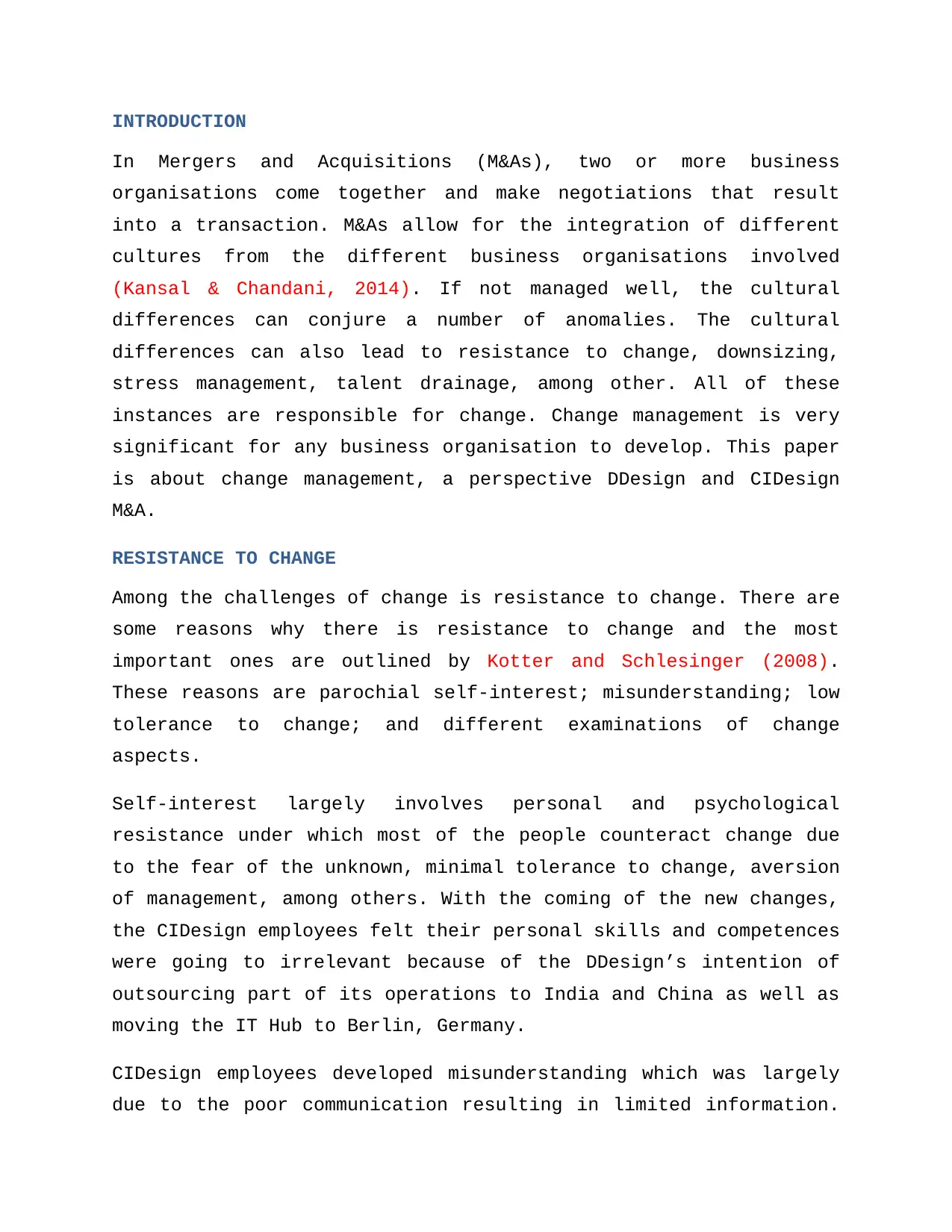
INTRODUCTION
In Mergers and Acquisitions (M&As), two or more business
organisations come together and make negotiations that result
into a transaction. M&As allow for the integration of different
cultures from the different business organisations involved
(Kansal & Chandani, 2014). If not managed well, the cultural
differences can conjure a number of anomalies. The cultural
differences can also lead to resistance to change, downsizing,
stress management, talent drainage, among other. All of these
instances are responsible for change. Change management is very
significant for any business organisation to develop. This paper
is about change management, a perspective DDesign and CIDesign
M&A.
RESISTANCE TO CHANGE
Among the challenges of change is resistance to change. There are
some reasons why there is resistance to change and the most
important ones are outlined by Kotter and Schlesinger (2008).
These reasons are parochial self-interest; misunderstanding; low
tolerance to change; and different examinations of change
aspects.
Self-interest largely involves personal and psychological
resistance under which most of the people counteract change due
to the fear of the unknown, minimal tolerance to change, aversion
of management, among others. With the coming of the new changes,
the CIDesign employees felt their personal skills and competences
were going to irrelevant because of the DDesign’s intention of
outsourcing part of its operations to India and China as well as
moving the IT Hub to Berlin, Germany.
CIDesign employees developed misunderstanding which was largely
due to the poor communication resulting in limited information.
In Mergers and Acquisitions (M&As), two or more business
organisations come together and make negotiations that result
into a transaction. M&As allow for the integration of different
cultures from the different business organisations involved
(Kansal & Chandani, 2014). If not managed well, the cultural
differences can conjure a number of anomalies. The cultural
differences can also lead to resistance to change, downsizing,
stress management, talent drainage, among other. All of these
instances are responsible for change. Change management is very
significant for any business organisation to develop. This paper
is about change management, a perspective DDesign and CIDesign
M&A.
RESISTANCE TO CHANGE
Among the challenges of change is resistance to change. There are
some reasons why there is resistance to change and the most
important ones are outlined by Kotter and Schlesinger (2008).
These reasons are parochial self-interest; misunderstanding; low
tolerance to change; and different examinations of change
aspects.
Self-interest largely involves personal and psychological
resistance under which most of the people counteract change due
to the fear of the unknown, minimal tolerance to change, aversion
of management, among others. With the coming of the new changes,
the CIDesign employees felt their personal skills and competences
were going to irrelevant because of the DDesign’s intention of
outsourcing part of its operations to India and China as well as
moving the IT Hub to Berlin, Germany.
CIDesign employees developed misunderstanding which was largely
due to the poor communication resulting in limited information.
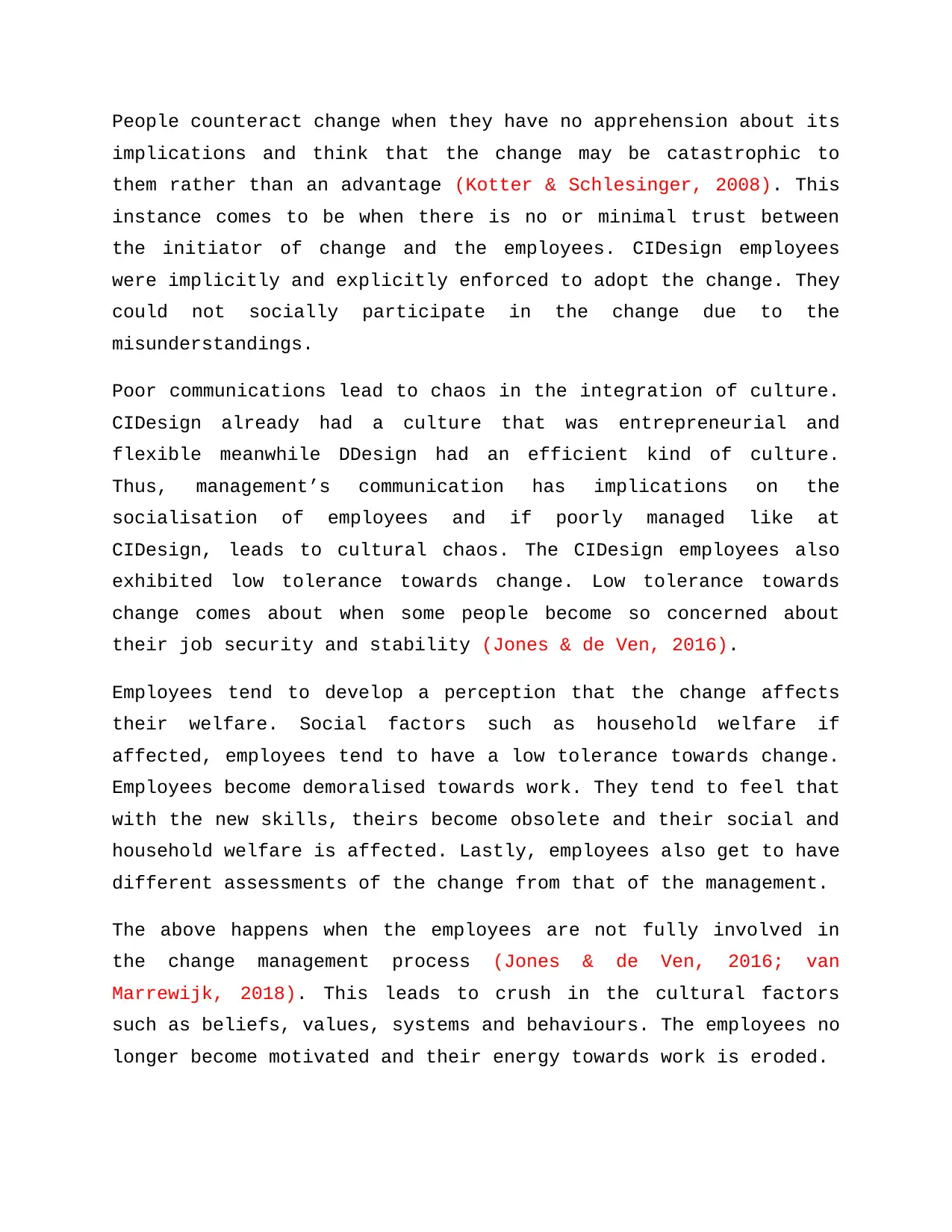
People counteract change when they have no apprehension about its
implications and think that the change may be catastrophic to
them rather than an advantage (Kotter & Schlesinger, 2008). This
instance comes to be when there is no or minimal trust between
the initiator of change and the employees. CIDesign employees
were implicitly and explicitly enforced to adopt the change. They
could not socially participate in the change due to the
misunderstandings.
Poor communications lead to chaos in the integration of culture.
CIDesign already had a culture that was entrepreneurial and
flexible meanwhile DDesign had an efficient kind of culture.
Thus, management’s communication has implications on the
socialisation of employees and if poorly managed like at
CIDesign, leads to cultural chaos. The CIDesign employees also
exhibited low tolerance towards change. Low tolerance towards
change comes about when some people become so concerned about
their job security and stability (Jones & de Ven, 2016).
Employees tend to develop a perception that the change affects
their welfare. Social factors such as household welfare if
affected, employees tend to have a low tolerance towards change.
Employees become demoralised towards work. They tend to feel that
with the new skills, theirs become obsolete and their social and
household welfare is affected. Lastly, employees also get to have
different assessments of the change from that of the management.
The above happens when the employees are not fully involved in
the change management process (Jones & de Ven, 2016; van
Marrewijk, 2018). This leads to crush in the cultural factors
such as beliefs, values, systems and behaviours. The employees no
longer become motivated and their energy towards work is eroded.
implications and think that the change may be catastrophic to
them rather than an advantage (Kotter & Schlesinger, 2008). This
instance comes to be when there is no or minimal trust between
the initiator of change and the employees. CIDesign employees
were implicitly and explicitly enforced to adopt the change. They
could not socially participate in the change due to the
misunderstandings.
Poor communications lead to chaos in the integration of culture.
CIDesign already had a culture that was entrepreneurial and
flexible meanwhile DDesign had an efficient kind of culture.
Thus, management’s communication has implications on the
socialisation of employees and if poorly managed like at
CIDesign, leads to cultural chaos. The CIDesign employees also
exhibited low tolerance towards change. Low tolerance towards
change comes about when some people become so concerned about
their job security and stability (Jones & de Ven, 2016).
Employees tend to develop a perception that the change affects
their welfare. Social factors such as household welfare if
affected, employees tend to have a low tolerance towards change.
Employees become demoralised towards work. They tend to feel that
with the new skills, theirs become obsolete and their social and
household welfare is affected. Lastly, employees also get to have
different assessments of the change from that of the management.
The above happens when the employees are not fully involved in
the change management process (Jones & de Ven, 2016; van
Marrewijk, 2018). This leads to crush in the cultural factors
such as beliefs, values, systems and behaviours. The employees no
longer become motivated and their energy towards work is eroded.
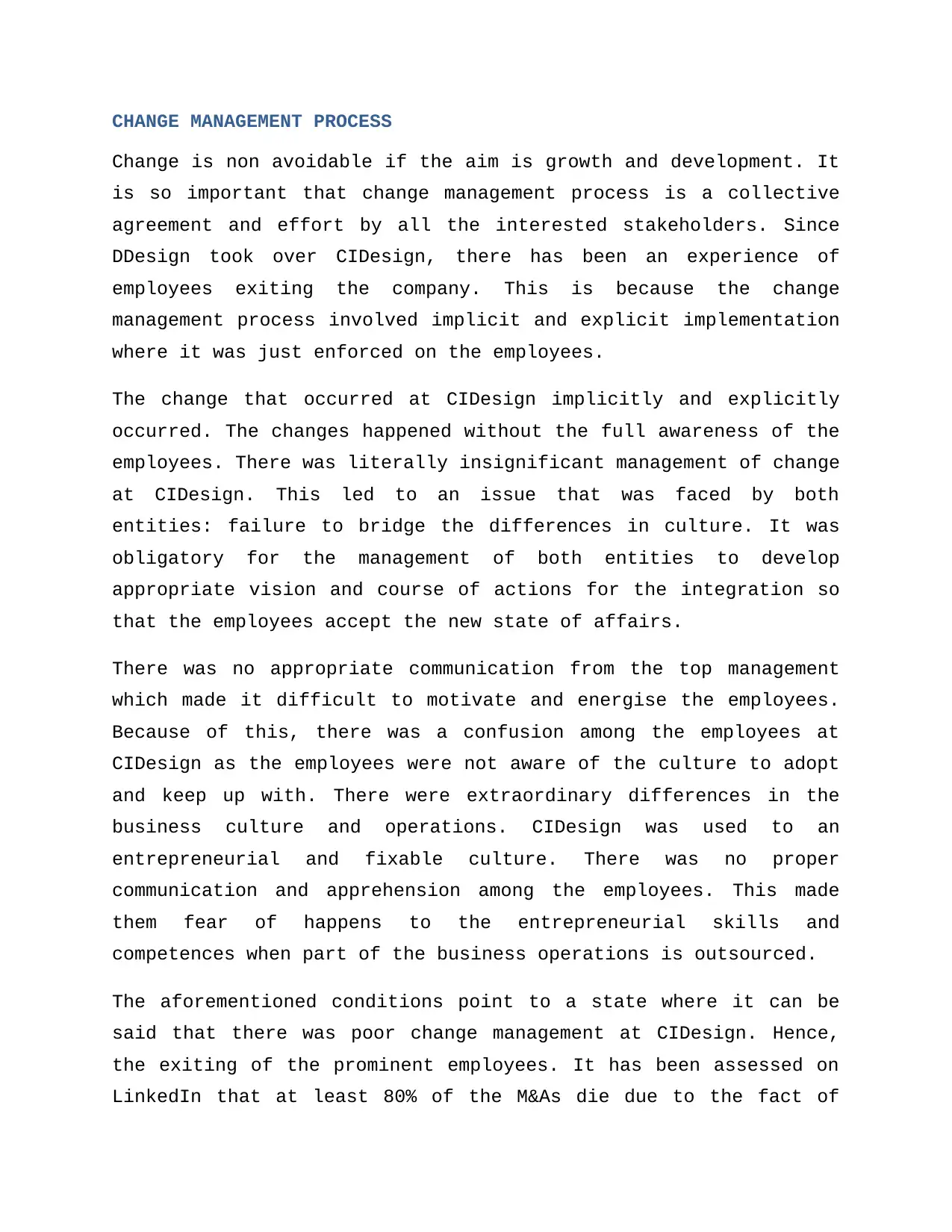
CHANGE MANAGEMENT PROCESS
Change is non avoidable if the aim is growth and development. It
is so important that change management process is a collective
agreement and effort by all the interested stakeholders. Since
DDesign took over CIDesign, there has been an experience of
employees exiting the company. This is because the change
management process involved implicit and explicit implementation
where it was just enforced on the employees.
The change that occurred at CIDesign implicitly and explicitly
occurred. The changes happened without the full awareness of the
employees. There was literally insignificant management of change
at CIDesign. This led to an issue that was faced by both
entities: failure to bridge the differences in culture. It was
obligatory for the management of both entities to develop
appropriate vision and course of actions for the integration so
that the employees accept the new state of affairs.
There was no appropriate communication from the top management
which made it difficult to motivate and energise the employees.
Because of this, there was a confusion among the employees at
CIDesign as the employees were not aware of the culture to adopt
and keep up with. There were extraordinary differences in the
business culture and operations. CIDesign was used to an
entrepreneurial and fixable culture. There was no proper
communication and apprehension among the employees. This made
them fear of happens to the entrepreneurial skills and
competences when part of the business operations is outsourced.
The aforementioned conditions point to a state where it can be
said that there was poor change management at CIDesign. Hence,
the exiting of the prominent employees. It has been assessed on
LinkedIn that at least 80% of the M&As die due to the fact of
Change is non avoidable if the aim is growth and development. It
is so important that change management process is a collective
agreement and effort by all the interested stakeholders. Since
DDesign took over CIDesign, there has been an experience of
employees exiting the company. This is because the change
management process involved implicit and explicit implementation
where it was just enforced on the employees.
The change that occurred at CIDesign implicitly and explicitly
occurred. The changes happened without the full awareness of the
employees. There was literally insignificant management of change
at CIDesign. This led to an issue that was faced by both
entities: failure to bridge the differences in culture. It was
obligatory for the management of both entities to develop
appropriate vision and course of actions for the integration so
that the employees accept the new state of affairs.
There was no appropriate communication from the top management
which made it difficult to motivate and energise the employees.
Because of this, there was a confusion among the employees at
CIDesign as the employees were not aware of the culture to adopt
and keep up with. There were extraordinary differences in the
business culture and operations. CIDesign was used to an
entrepreneurial and fixable culture. There was no proper
communication and apprehension among the employees. This made
them fear of happens to the entrepreneurial skills and
competences when part of the business operations is outsourced.
The aforementioned conditions point to a state where it can be
said that there was poor change management at CIDesign. Hence,
the exiting of the prominent employees. It has been assessed on
LinkedIn that at least 80% of the M&As die due to the fact of
Secure Best Marks with AI Grader
Need help grading? Try our AI Grader for instant feedback on your assignments.
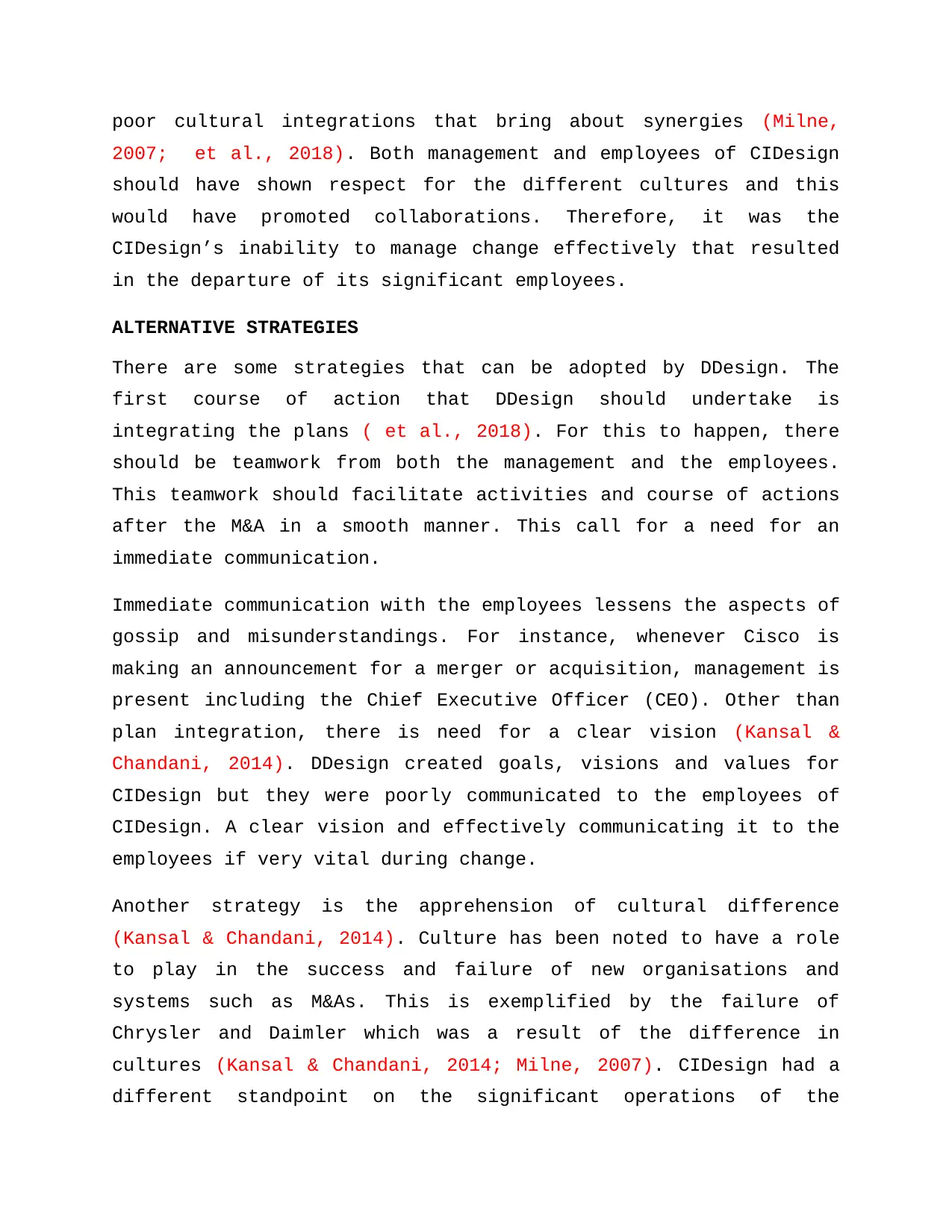
poor cultural integrations that bring about synergies (Milne,
2007; et al., 2018). Both management and employees of CIDesign
should have shown respect for the different cultures and this
would have promoted collaborations. Therefore, it was the
CIDesign’s inability to manage change effectively that resulted
in the departure of its significant employees.
ALTERNATIVE STRATEGIES
There are some strategies that can be adopted by DDesign. The
first course of action that DDesign should undertake is
integrating the plans ( et al., 2018). For this to happen, there
should be teamwork from both the management and the employees.
This teamwork should facilitate activities and course of actions
after the M&A in a smooth manner. This call for a need for an
immediate communication.
Immediate communication with the employees lessens the aspects of
gossip and misunderstandings. For instance, whenever Cisco is
making an announcement for a merger or acquisition, management is
present including the Chief Executive Officer (CEO). Other than
plan integration, there is need for a clear vision (Kansal &
Chandani, 2014). DDesign created goals, visions and values for
CIDesign but they were poorly communicated to the employees of
CIDesign. A clear vision and effectively communicating it to the
employees if very vital during change.
Another strategy is the apprehension of cultural difference
(Kansal & Chandani, 2014). Culture has been noted to have a role
to play in the success and failure of new organisations and
systems such as M&As. This is exemplified by the failure of
Chrysler and Daimler which was a result of the difference in
cultures (Kansal & Chandani, 2014; Milne, 2007). CIDesign had a
different standpoint on the significant operations of the
2007; et al., 2018). Both management and employees of CIDesign
should have shown respect for the different cultures and this
would have promoted collaborations. Therefore, it was the
CIDesign’s inability to manage change effectively that resulted
in the departure of its significant employees.
ALTERNATIVE STRATEGIES
There are some strategies that can be adopted by DDesign. The
first course of action that DDesign should undertake is
integrating the plans ( et al., 2018). For this to happen, there
should be teamwork from both the management and the employees.
This teamwork should facilitate activities and course of actions
after the M&A in a smooth manner. This call for a need for an
immediate communication.
Immediate communication with the employees lessens the aspects of
gossip and misunderstandings. For instance, whenever Cisco is
making an announcement for a merger or acquisition, management is
present including the Chief Executive Officer (CEO). Other than
plan integration, there is need for a clear vision (Kansal &
Chandani, 2014). DDesign created goals, visions and values for
CIDesign but they were poorly communicated to the employees of
CIDesign. A clear vision and effectively communicating it to the
employees if very vital during change.
Another strategy is the apprehension of cultural difference
(Kansal & Chandani, 2014). Culture has been noted to have a role
to play in the success and failure of new organisations and
systems such as M&As. This is exemplified by the failure of
Chrysler and Daimler which was a result of the difference in
cultures (Kansal & Chandani, 2014; Milne, 2007). CIDesign had a
different standpoint on the significant operations of the
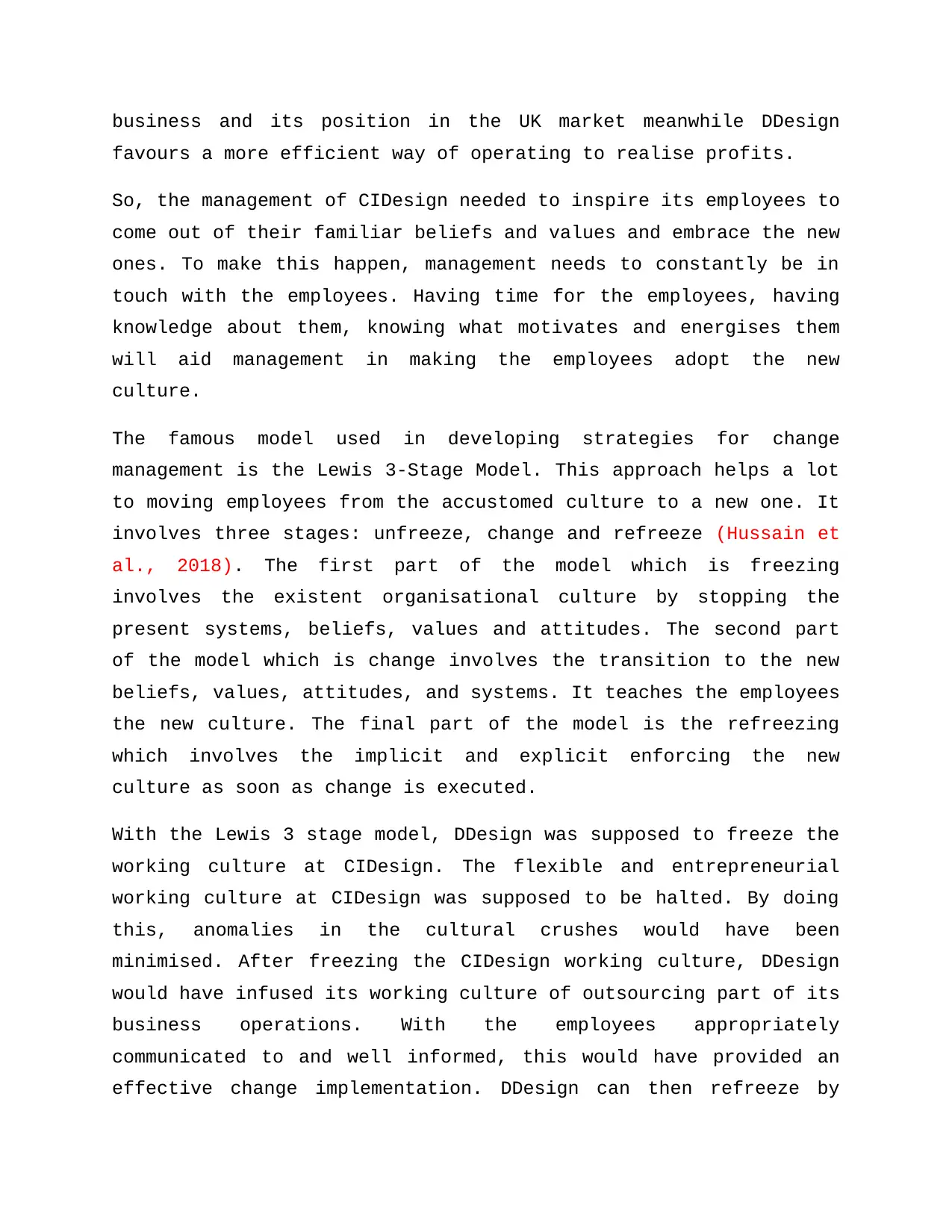
business and its position in the UK market meanwhile DDesign
favours a more efficient way of operating to realise profits.
So, the management of CIDesign needed to inspire its employees to
come out of their familiar beliefs and values and embrace the new
ones. To make this happen, management needs to constantly be in
touch with the employees. Having time for the employees, having
knowledge about them, knowing what motivates and energises them
will aid management in making the employees adopt the new
culture.
The famous model used in developing strategies for change
management is the Lewis 3-Stage Model. This approach helps a lot
to moving employees from the accustomed culture to a new one. It
involves three stages: unfreeze, change and refreeze (Hussain et
al., 2018). The first part of the model which is freezing
involves the existent organisational culture by stopping the
present systems, beliefs, values and attitudes. The second part
of the model which is change involves the transition to the new
beliefs, values, attitudes, and systems. It teaches the employees
the new culture. The final part of the model is the refreezing
which involves the implicit and explicit enforcing the new
culture as soon as change is executed.
With the Lewis 3 stage model, DDesign was supposed to freeze the
working culture at CIDesign. The flexible and entrepreneurial
working culture at CIDesign was supposed to be halted. By doing
this, anomalies in the cultural crushes would have been
minimised. After freezing the CIDesign working culture, DDesign
would have infused its working culture of outsourcing part of its
business operations. With the employees appropriately
communicated to and well informed, this would have provided an
effective change implementation. DDesign can then refreeze by
favours a more efficient way of operating to realise profits.
So, the management of CIDesign needed to inspire its employees to
come out of their familiar beliefs and values and embrace the new
ones. To make this happen, management needs to constantly be in
touch with the employees. Having time for the employees, having
knowledge about them, knowing what motivates and energises them
will aid management in making the employees adopt the new
culture.
The famous model used in developing strategies for change
management is the Lewis 3-Stage Model. This approach helps a lot
to moving employees from the accustomed culture to a new one. It
involves three stages: unfreeze, change and refreeze (Hussain et
al., 2018). The first part of the model which is freezing
involves the existent organisational culture by stopping the
present systems, beliefs, values and attitudes. The second part
of the model which is change involves the transition to the new
beliefs, values, attitudes, and systems. It teaches the employees
the new culture. The final part of the model is the refreezing
which involves the implicit and explicit enforcing the new
culture as soon as change is executed.
With the Lewis 3 stage model, DDesign was supposed to freeze the
working culture at CIDesign. The flexible and entrepreneurial
working culture at CIDesign was supposed to be halted. By doing
this, anomalies in the cultural crushes would have been
minimised. After freezing the CIDesign working culture, DDesign
would have infused its working culture of outsourcing part of its
business operations. With the employees appropriately
communicated to and well informed, this would have provided an
effective change implementation. DDesign can then refreeze by
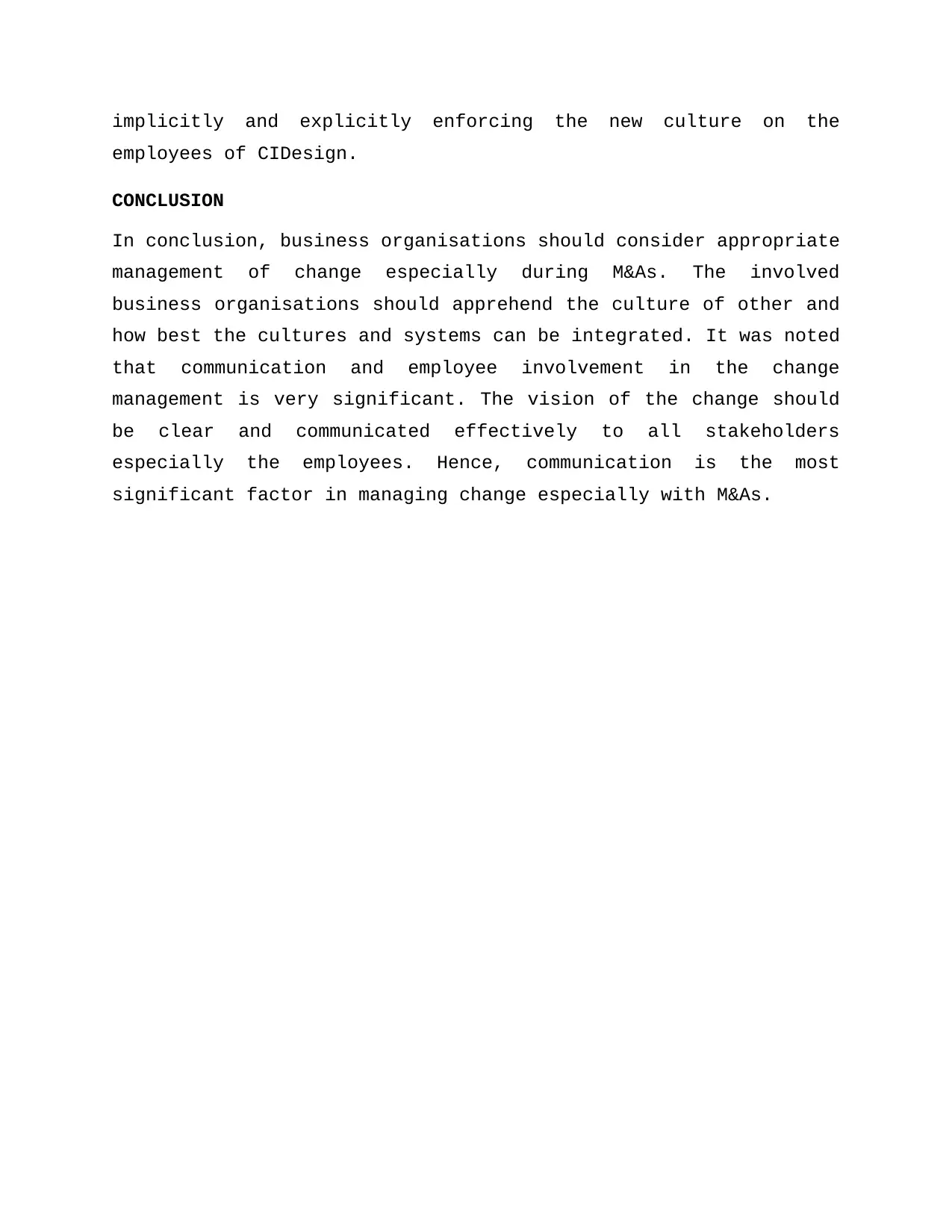
implicitly and explicitly enforcing the new culture on the
employees of CIDesign.
CONCLUSION
In conclusion, business organisations should consider appropriate
management of change especially during M&As. The involved
business organisations should apprehend the culture of other and
how best the cultures and systems can be integrated. It was noted
that communication and employee involvement in the change
management is very significant. The vision of the change should
be clear and communicated effectively to all stakeholders
especially the employees. Hence, communication is the most
significant factor in managing change especially with M&As.
employees of CIDesign.
CONCLUSION
In conclusion, business organisations should consider appropriate
management of change especially during M&As. The involved
business organisations should apprehend the culture of other and
how best the cultures and systems can be integrated. It was noted
that communication and employee involvement in the change
management is very significant. The vision of the change should
be clear and communicated effectively to all stakeholders
especially the employees. Hence, communication is the most
significant factor in managing change especially with M&As.
Paraphrase This Document
Need a fresh take? Get an instant paraphrase of this document with our AI Paraphraser
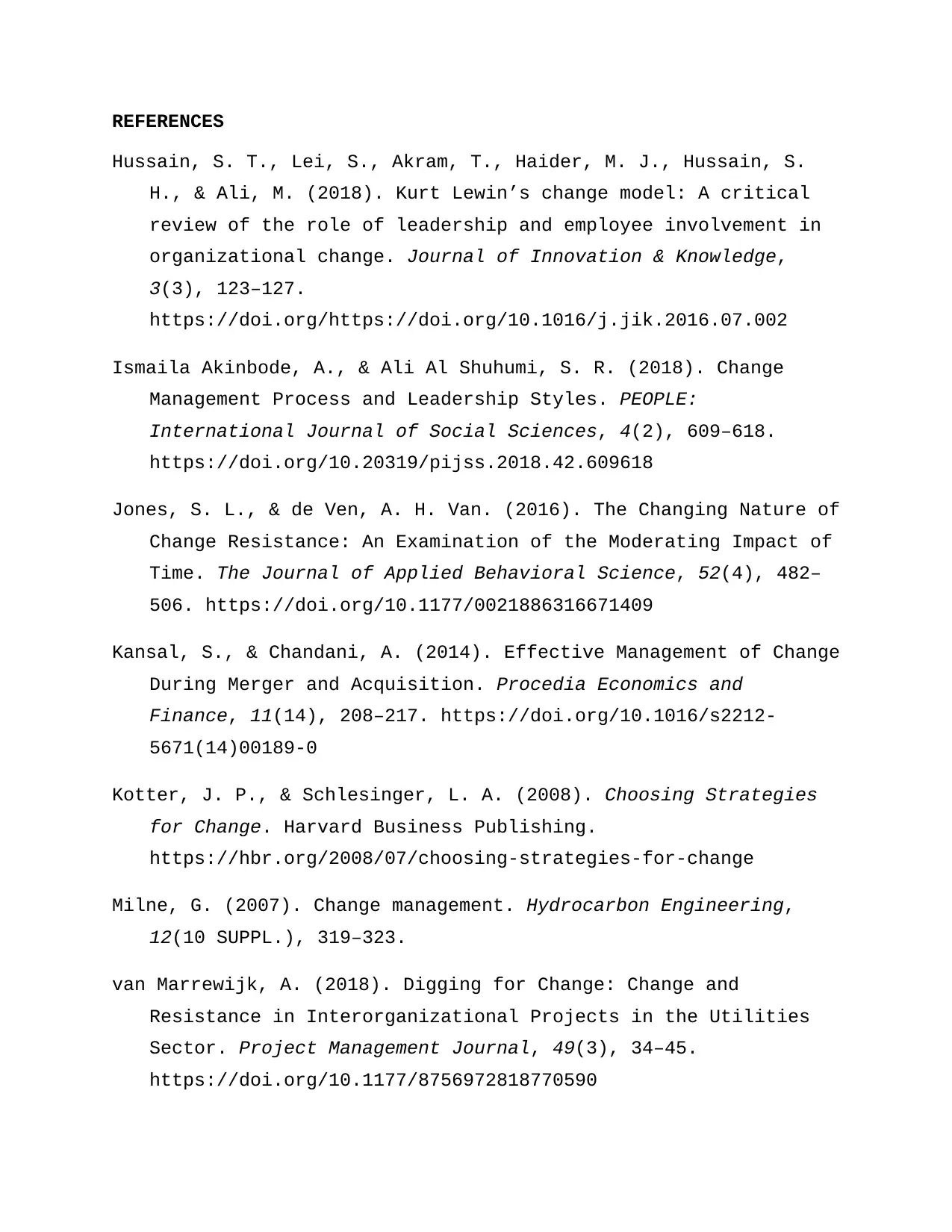
REFERENCES
Hussain, S. T., Lei, S., Akram, T., Haider, M. J., Hussain, S.
H., & Ali, M. (2018). Kurt Lewin’s change model: A critical
review of the role of leadership and employee involvement in
organizational change. Journal of Innovation & Knowledge,
3(3), 123–127.
https://doi.org/https://doi.org/10.1016/j.jik.2016.07.002
Ismaila Akinbode, A., & Ali Al Shuhumi, S. R. (2018). Change
Management Process and Leadership Styles. PEOPLE:
International Journal of Social Sciences, 4(2), 609–618.
https://doi.org/10.20319/pijss.2018.42.609618
Jones, S. L., & de Ven, A. H. Van. (2016). The Changing Nature of
Change Resistance: An Examination of the Moderating Impact of
Time. The Journal of Applied Behavioral Science, 52(4), 482–
506. https://doi.org/10.1177/0021886316671409
Kansal, S., & Chandani, A. (2014). Effective Management of Change
During Merger and Acquisition. Procedia Economics and
Finance, 11(14), 208–217. https://doi.org/10.1016/s2212-
5671(14)00189-0
Kotter, J. P., & Schlesinger, L. A. (2008). Choosing Strategies
for Change. Harvard Business Publishing.
https://hbr.org/2008/07/choosing-strategies-for-change
Milne, G. (2007). Change management. Hydrocarbon Engineering,
12(10 SUPPL.), 319–323.
van Marrewijk, A. (2018). Digging for Change: Change and
Resistance in Interorganizational Projects in the Utilities
Sector. Project Management Journal, 49(3), 34–45.
https://doi.org/10.1177/8756972818770590
Hussain, S. T., Lei, S., Akram, T., Haider, M. J., Hussain, S.
H., & Ali, M. (2018). Kurt Lewin’s change model: A critical
review of the role of leadership and employee involvement in
organizational change. Journal of Innovation & Knowledge,
3(3), 123–127.
https://doi.org/https://doi.org/10.1016/j.jik.2016.07.002
Ismaila Akinbode, A., & Ali Al Shuhumi, S. R. (2018). Change
Management Process and Leadership Styles. PEOPLE:
International Journal of Social Sciences, 4(2), 609–618.
https://doi.org/10.20319/pijss.2018.42.609618
Jones, S. L., & de Ven, A. H. Van. (2016). The Changing Nature of
Change Resistance: An Examination of the Moderating Impact of
Time. The Journal of Applied Behavioral Science, 52(4), 482–
506. https://doi.org/10.1177/0021886316671409
Kansal, S., & Chandani, A. (2014). Effective Management of Change
During Merger and Acquisition. Procedia Economics and
Finance, 11(14), 208–217. https://doi.org/10.1016/s2212-
5671(14)00189-0
Kotter, J. P., & Schlesinger, L. A. (2008). Choosing Strategies
for Change. Harvard Business Publishing.
https://hbr.org/2008/07/choosing-strategies-for-change
Milne, G. (2007). Change management. Hydrocarbon Engineering,
12(10 SUPPL.), 319–323.
van Marrewijk, A. (2018). Digging for Change: Change and
Resistance in Interorganizational Projects in the Utilities
Sector. Project Management Journal, 49(3), 34–45.
https://doi.org/10.1177/8756972818770590
1 out of 8
Your All-in-One AI-Powered Toolkit for Academic Success.
+13062052269
info@desklib.com
Available 24*7 on WhatsApp / Email
![[object Object]](/_next/static/media/star-bottom.7253800d.svg)
Unlock your academic potential
© 2024 | Zucol Services PVT LTD | All rights reserved.



